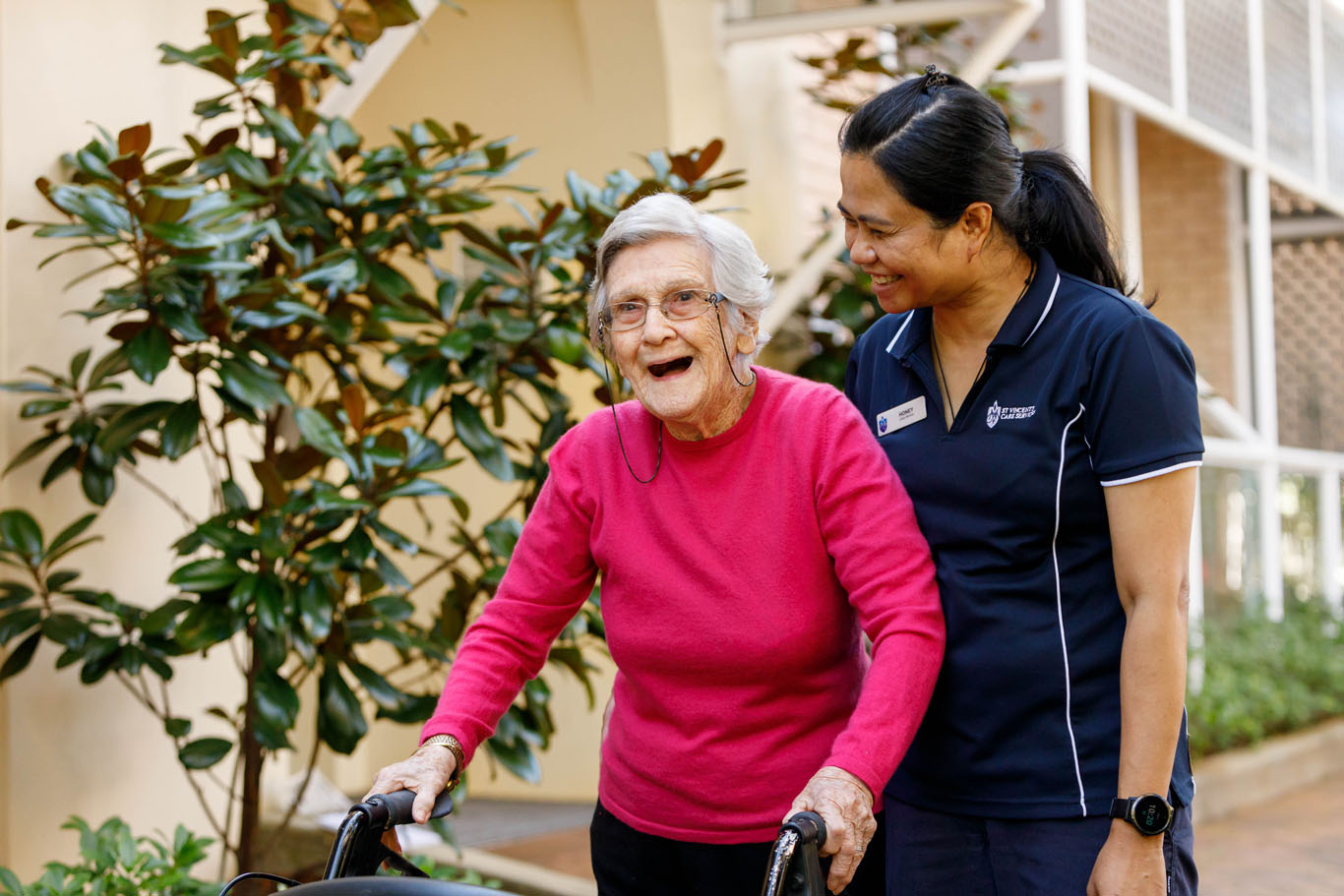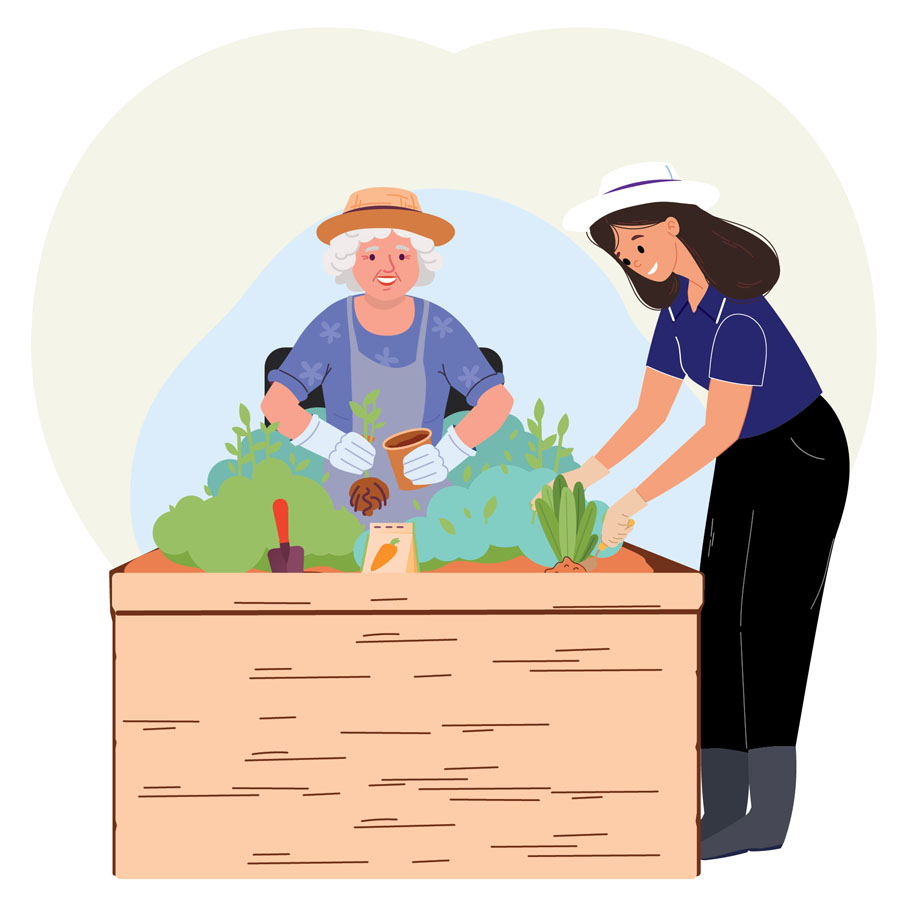What is Dignity of Risk in Aged Care?
How it works | Examples in aged care
Posted 31st May 2024 | 5 minute read
Written by Jesse Gramenz 

Dignity of Risk is the idea that people in aged care have the right to live the way they want to, even if it sometimes involves risk. But how do aged care providers and residents get to that point? And what does that look like in reality? Let's find out.
Understanding Dignity of Risk
Dignity of Risk refers to the right of individuals, particularly the elderly or those with disabilities, to take reasonable risks.
It's a really important concept. Why?
Because it challenges the overprotective tendencies often seen in caregiving contexts.
"We can't cotton wool a person. We have to accept that in living there is some level of risk and that the person will thrive if they are allowed to be autonomous, exercise agency and take risk where they feel is beneficial for them."
Facility Manager Mark Aros on Ep.4 of the Navigating Aged Care podcast
At its core, dignity of risk is about recognizing that the right to make choices—including potentially risky ones—is essential for personal dignity and self-esteem.
How does Dignity of Risk Work?
It's a lovely idea, that is letting people take control over their own lives. But because there's been a history of overprotectiveness in the aged care industry, residents, families and even some staff have to do some level of unlearning old ideas and habits, and make sure they're setting firm boundaries with care.
Here's a few ways that happens in an aged care setting:
1. Personalized Care Plans
In aged care, every plan for a resident's care is written down.
That way, no matter who is looking after a resident, staff should know exactly who they are and how they want to be cared for.
Not only that, but when it comes to having conversations with family, the requests of residents are clearly noted down so everyone is clear on what's happening.
That's what a strong, personalised care plan looks like
Read on:
2. Risk Assessment
Careful risk assessment is crucial to balance safety with autonomy. These assessments should not be about eliminating risk entirely but managing it in a way that respects a resident's ability to make informed decisions about their own lives.
3. Open Communication with Care Providers
Families should engage in open and ongoing dialogue with care providers about their loved one’s preferences, capabilities, and lifestyles. This communication ensures that care plans are personalized and respectful of the resident’s desires and risks they are willing to take. For instance, if a resident used to be an avid walker, the family can discuss how to safely integrate some form of walking or outdoor activity into their daily routine.
4. Emotional Preparation
Implementing dignity of risk can be emotionally challenging as it requires accepting that risks may lead to minor injuries or scenarios that might families uncomfortable. Families need to prepare themselves emotionally to handle these situations, understanding that the overall benefit to their loved one’s well-being and autonomy is often worth the risks.
When we hop in our car. When we walk on the pavement. We’re all taking risks. And that continues obviously into late life.
It’s often adult children that perceive that their parent is exposed to more risk than they ever have been before and therefore they feel responsible and feel like they have to step in and stop them from being in any kind of danger.
Appreciating that if the person has the capacity to engage in that risk, it is their choice
Clinical Psychologist Zoe Falster - Ep.4 of the Navigating Aged Care Podcast
Experts talk about dignity of risk and so much more on Episode 4 of the Navigating Aged Care Podcast
Examples of Dignity of Risk in an Aged Care Home
We've provided some example scenarios below of Dignity of Risk in aged care, but we recently caught up with aged care resident, Grace who summed it up beautifully:
I just broke all the rules last night.
I just told them [staff] I’m going out for dinner tonight. As long as you tell people what you’re doing. I went and had a lovely time.
It’s great. You’re not just bound to the facility. And I think that’s what frightens a lot of people.
And you’re not [stuck].
Sometimes I don’t even tell her [my daughter] and she finds out the next day.
“Guess what I did last night!”
Without any knowledge of who Grace is, families and even potential aged care staff might find this scenario a little frightening:
- What if Grace has a fall?
- What if she gets lost?
- How would she find her way home?
But, as you'll see in some of our other scenarios, aged care residents (just like everyone else) have to live life on their terms.
A good aged care provider will lay out the risks for things that seem risky, but at the end of the day, residents should always feel like they are in control of their lives -- not aged care providers.
Helen's Garden Walk
- Helen: An 82-year-old resident with mild mobility issues.
- Susan: Helen's daughter.
- Mark: A caregiver at the facility.
The Situation
Helen has always loved gardening, but since moving into the aged care facility, she's been mostly indoors due to concerns about her mobility.
One day, she expresses a strong desire to visit the garden unaided. Mark, her caregiver, assesses the risk and decides to respect Helen's autonomy while ensuring her safety. He discusses a plan with Helen and her daughter, Susan, that includes Helen using a walker and having a staff member discreetly monitor her from a distance.

Susan's Response
Susan is initially hesitant, worried about the risk of a fall. However, Mark explains the concept of dignity of risk, emphasizing Helen's happiness and the measures in place to minimize any chance of harm. Susan agrees, understanding the importance of her mother's independence and the joy the garden brings her.
How Mark Helps
Mark arranges for regular, safe pathways for Helen to use, and schedules times when the garden is quiet so Helen can enjoy her time without the area being too busy. This plan allows Helen the pleasure of gardening while maintaining safety protocols.
For families and relatives to thrive, it’s accepting that some of the decisions they [residents] make about themselves may include risks that you may not feel comfortable with.
There’s a lot of things I do that others might consider risky. Scuba diving is one of those things. But it brings a lot of joy.
We just have to accept that as an adult that if you’ve come in with a history of falls but you like to go for walks, you may fall. But what the home will do is try to mitigate against injury.
Facility Manager Mark Aros on Ep.4 of the Navigating Aged Care podcast
Joe's Cooking Club
- Joe: A 75-year-old resident who was a chef before retirement.
- Tina: Joe's niece.
- Nancy: Aged care facility activities coordinator.
The Situation
Joe misses cooking dearly and wants to participate in the kitchen, something the staff usually restricts due to safety policies. Nancy, the activities coordinator, sees an opportunity to engage Joe in a cooking club designed for residents, with appropriate safeguards.
Tina's Response
Tina, Joe's niece, learns about the cooking club and initially fears for Joe's safety around kitchen appliances. However, Nancy explains how the cooking activities are tailored to ensure the residents' safety, such as using utensils that are suitable for their abilities and having staff supervision at all times. Tina appreciates the thoughtfulness in maintaining Joe's dignity and giving him a sense of purpose.
How Nancy Helps
Nancy organizes the cooking club with sessions that accommodate the residents' physical limitations. She includes Joe in planning the menu, which boosts his morale and engagement. The club uses adaptive kitchen tools that reduce the risk of injury, and staff members are always present to assist.
Betty's Late Nights
- Betty: An 89-year-old resident with insomnia.
- Greg: Betty's son.
- Lisa: Night shift nurse
The Situation
Betty enjoys staying up late, a habit that conflicts with the usual bedtime routines at the facility. Instead of forcing her to adapt, Lisa, the night nurse, creates a safe space for Betty to read and relax in the common area during the hours she's awake.
Greg's Response
Greg worries about his mother being alone at night, concerned she might get disoriented or fall. Lisa explains how allowing Betty some freedom at night respects her lifelong patterns and can improve her overall wellbeing. She reassures Greg with details of the measures in place to ensure Betty’s safety, including regular check-ins.
How Lisa Helps
Lisa sets up a cozy nook in the common area with comfortable seating and good lighting. She schedules her rounds to ensure she checks on Betty periodically, balancing Betty's independence with the need for safety.
Reflection
These stories illustrate how dignity of risk can be implemented in aged care settings, showing that with thoughtful consideration and careful planning, staff can support residents in living more fulfilling lives. Families, when informed properly, can understand and support these measures, seeing them not as risks but as opportunities for their loved ones to thrive.
Parting Thoughts
Dignity of Risk is something that is afforded to everyone. But as we get older, a microscope tends to get placed over the risks we take every day and take for granted.
By acknowledging risk and finding ways to work around it as we get older (and particularly in aged care), we can keep safe but also maintain a sense of purpose and pride in our lives by still doing the things we love every day.
Still have questions?
CHAT TO OUR AGED CARE EXPERTS
- Home
- Residential Aged Care
- What is Dignity of Risk in Aged Care? [With Examples]
Helpful Information

What is an ACAT assessment? (and how to get the most out of it)

What is a Care Plan in Aged Care?
